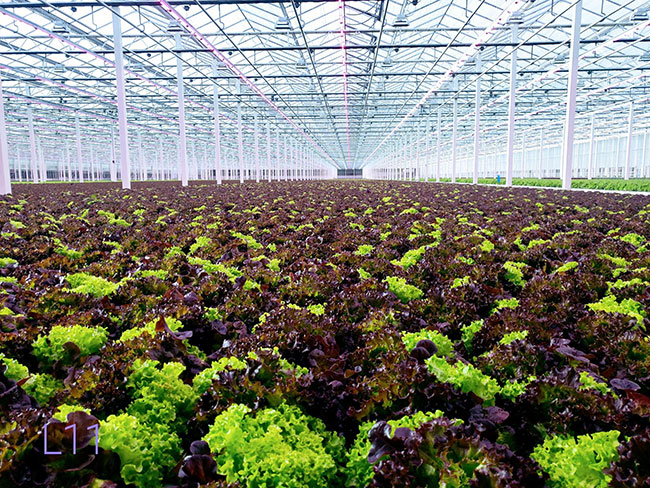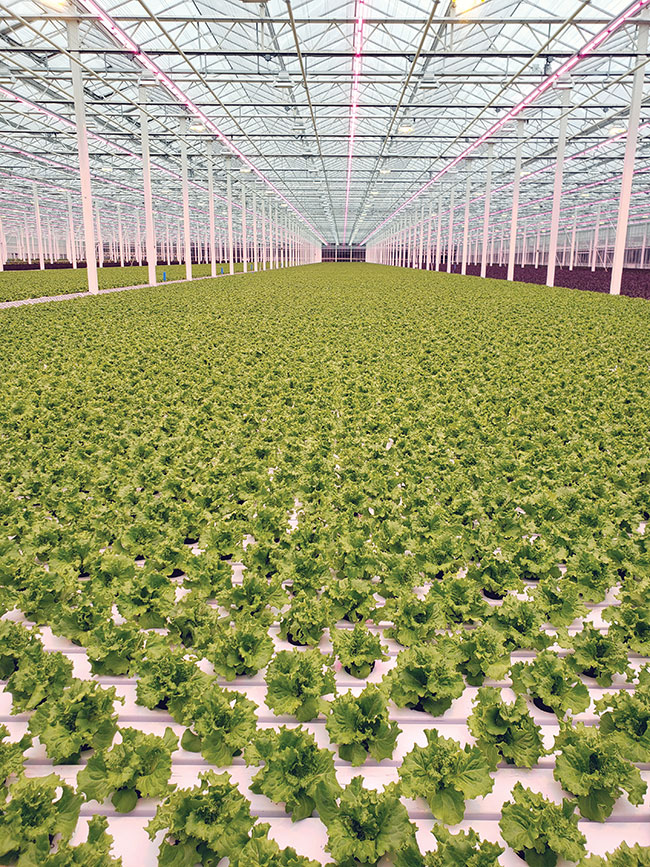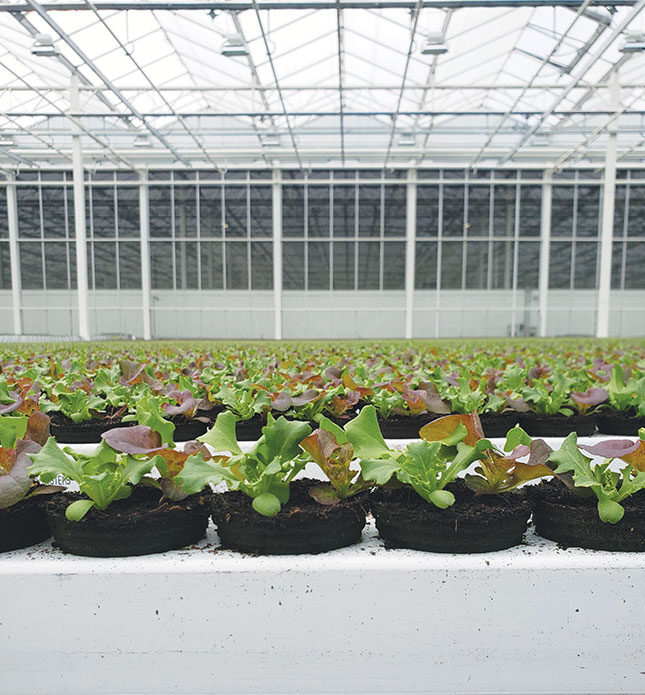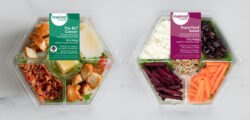
Features
Business
Grower Profiles
Marketing
Retail
Trends
Tasteful production of greenhouse lettuce
Purpose-built Alberta greenhouse continuously searches for ways to finetune specialized lettuce production.
December 21, 2021 By Greta Chiu
 An inside look at the Whole Leaf greenhouse facility located in Lethbridge County, Alta. It was purpose-built for growing lettuce.
All photos courtesy of Whole Leaf, The Star Group
An inside look at the Whole Leaf greenhouse facility located in Lethbridge County, Alta. It was purpose-built for growing lettuce.
All photos courtesy of Whole Leaf, The Star Group Deep in the heart of southern Alberta lies Whole Leaf, a five-hectare greenhouse that was not only purpose-built for lettuce production, but specializes in the consumer taste experience.
“It’s fully automated [and] fully robotic, so we can be more cost competitive and close the cost parity gap with field-grown. We are striving to provide the ultimate freshness and taste experience,” explains David Karwacki, co-founder and CEO of the Star Group, which owns and operates Whole Leaf in Lethbridge County, Alta. The greenhouse produces approximately 18 million heads annually, allowing them to generate the same amount of produce as 600 field acres.
The Star Group has set their sights on the future of smart growing, and Karwacki says Whole Leaf is their north star. In addition to sophisticated automation, the facility sequesters CO2, uses waste heat, feeds electricity back into the grid, and is meticulously conscious of water waste and consumption.
“We’re only using one litre of water per head of lettuce,” he says, comparing it to the average 100 to 150 litres typically employed in field production. They chose the nutrient film technique (NFT) as a way to gain greater control over the growing environment. The water is run through a filtration system that includes ultraviolet and microfiltration and is tested frequently ensuring cleanliness and safety.
“For me, the best thing is it’s pesticide-free,” says Karwacki.
The first 2.5 hectares were completed in 2017 followed by an immediate 2.5-hectare expansion completed in 2019. The greenhouse was specially outfitted to grow whole heads of lettuce, sold either in a living format or washed and ready for consumption in packaged clamshells.

Working closely with seed providers and breeders, Whole Leaf experiments with their production practices to get the right characteristics for each target segment.
It took the team two years to get a good understanding of the growing conditions and technology. “It’s a constant learning environment that challenges our growing team to continue raising the bar on what’s possible for greenhouse leafy greens,” he says.
There was a lot of trial and error. No one had the expertise that could tell them exactly how to execute it. They needed to understand how the technology worked together and in conjunction with the environment.
“We are able to control all of the different variables, but when a chinook comes off the mountains of southern Alberta, and the temperature outside our greenhouse changes by 25 to 30 degrees in an hour? That can have very, very dramatic effects on the crop.”
Climate, humidity deficits, night- and day-time temperatures, CO2, varietals, as well as the water’s flow, temperature, and nutrients – every variable influences the final product. As for lighting, Whole Leaf soaks in as much sunlight as possible, supplementing with artificial light when needed to grow year-round.
Look, feel, taste and texture
Growing for both retail markets and restaurants, Whole Leaf produces seven different types of greens across nine varieties and each one is tailored specifically to a segment and client. In 2020, quick-service restaurant chain, Wendy’s Canada, launched a campaign to source only Canadian greenhouse-grown lettuce for their burgers and salads – all supplied by Whole Leaf.
“Restauranteurs want the perfect burger leaf,” Karwacki explains. “We can grow a head of lettuce with perfect leaves on it, and it takes all of the work out of the back shop where they do not have to carve up the lettuce anymore like they used to.” Not only are the leaves uniform in size, the team has also worked to grow varieties of lettuce with greater resistance to wilting, a textural frill along the margins and a lighter, more blonde colour.
As for consumers shopping at retail grocers? They’re focused on freshness, crunch and taste, says Karwacki. Sold under their consumer brand Inspired Greens, the Tender & Tasty Trio living lettuce has been one of their most popular products. Each trio head contains a bouquet of three different leaf types, offering a contrast of taste, texture and convenience in just one cut.
To ensure the right characteristics, Whole Leaf not only changes up their growing practices but works with seed companies worldwide. Trials are conducted right inside their greenhouse, allowing them to efficiently address feedback from retailers and food service providers. “That may take two [to] four years to cycle through the process [to] get what consumers are really looking for,” Karwacki says. “Ultimately, our objective is to find and grow lettuces that consumers love.”

Producing for both food service and retail markets, the team continuously stays in tune with what consumers and restauranteurs are each looking for.
“You can get anything from nutty to peppery to buttery. The crunch and crispness, the texture of the lettuce, [they] play into the taste profile, the mouthfeel that you’re going to get out of it,” says Karwacki. Where the deeper green lettuces often deliver a more earthy taste, the blonder types have a higher level of sweetness. While most red varieties tend to be bitter, Karwacki says theirs are not, which is an unusual and positive surprise.
“A lot of lettuce was bred for the field and really was not particularly oriented for greenhouse growing,” he explains. But here, they’ve seen a big shift in recent years. “There are all kinds of taste profiles out there. Breeders are doing an outstanding job in coming up with new varieties that work in the greenhouses to bring out better flavours and better crunch and the characteristics that will delight consumers.”
By going back to the genetics, revising their growing practices and better understanding consumer wants, Whole Leaf has seemingly uncovered a formula that resonates with today’s markets. It’s an approach that the Star Group is using to fuel their latest venture in B.C. with greenhouse strawberries, and it’s also well-timed.
With a rise in home cooking spurred by the COVID pandemic, Karwacki has seen consumers becoming increasingly aware of the products they consume.
“When you think about the food provenance movement, and how people are wanting to understand where their food is coming from, how it’s being grown [and] handled – that’s becoming more and more important. And I think in the face of COVID, it’s become even more acute.”
The start of a fruitful venture
Similar to Whole Leaf’s approach to lettuce, The Star Group is working on combining the right genetics with the right environmental conditions for year-round production of greenhouse strawberries, led by BC Hot House Foods in Surrey.
“Strawberries are very difficult to grow and very complex,” says David Karwacki. “Often times, they’re bred for yield and they’re bred for shelf life, but not necessarily bred for taste.”
“But when … they’re red all the way through, they explode in your mouth, and they have a great sweet taste at the front and maybe a little bit of acid at the back? Boy, you just can’t stop eating them.”
The project received $380,000 in support via the Canada-British Columbia Agri-Innovation Program in 2020. They’ve since been working with their partners in Europe to create a feasible cultivation method under lights.
“You can do it, but can you do it economically?” Karwacki poses. “Can you get the right taste [and] … berries that have the same size, texture, taste, colour and shape that you want? It’s a pretty exciting project to be a part of.”
Expanding consumer reach
 In 2020, The Star Group launched their InspiredGO digital platform, which delivers their pre-packaged Inspired Salads straight to consumer homes and offices in Calgary, Vancouver, Edmonton, Saskatoon and Winnipeg.
In 2020, The Star Group launched their InspiredGO digital platform, which delivers their pre-packaged Inspired Salads straight to consumer homes and offices in Calgary, Vancouver, Edmonton, Saskatoon and Winnipeg.
Throughout the COVID pandemic, their team has provided over 15,000 meals and counting to frontline workers.
2021 was a year of recognition for the company. Whole Leaf’s Inspired Salads won the award for Best New Product at the 2021 CPMA showcase earlier this year. Their Wendy’s Sandwich Leaves & Salad Blend won the Innovative New Product Award at the 2021 CEA Awards, presented by technology supplier, Artemis.
Print this page